Cancer: Diagnosis, Staging, Complications, and Patient Support
VerifiedAdded on 2022/10/15
|9
|2539
|11
Report
AI Summary
This report provides a comprehensive overview of cancer, encompassing its diagnosis, staging, and various complications. It delves into the methods used for diagnosis, including the TNM system, and details the different stages of cancer, from in situ to metastasis. The report also addresses the physical and psychological complications associated with cancer, such as pain, fatigue, and mood disorders, alongside the side effects of treatments like chemotherapy and radiation. Furthermore, it explores factors contributing to cancer incidence and mortality, such as substance abuse and lifestyle choices. The report highlights the role of the American Cancer Society in providing education and support and illustrates the nursing process in delivering effective and safe care to cancer patients. The importance of undergraduate education as a foundation for nursing practice is also discussed, offering a well-rounded perspective on cancer and its management.

Running head: ISSUES OF CANCER 1
Issues of Cancer
Name
Institution
Issues of Cancer
Name
Institution
Paraphrase This Document
Need a fresh take? Get an instant paraphrase of this document with our AI Paraphraser
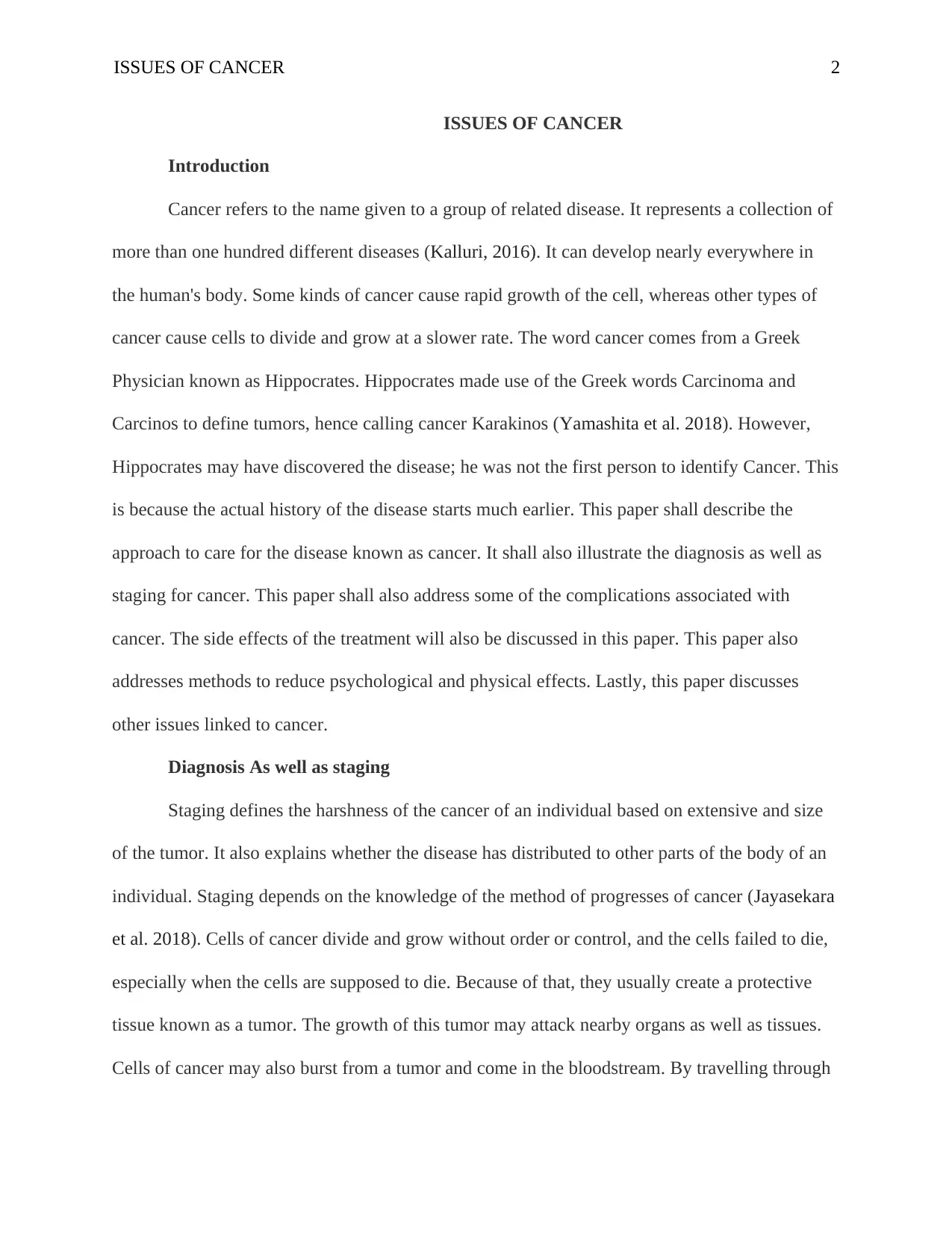
ISSUES OF CANCER 2
ISSUES OF CANCER
Introduction
Cancer refers to the name given to a group of related disease. It represents a collection of
more than one hundred different diseases (Kalluri, 2016). It can develop nearly everywhere in
the human's body. Some kinds of cancer cause rapid growth of the cell, whereas other types of
cancer cause cells to divide and grow at a slower rate. The word cancer comes from a Greek
Physician known as Hippocrates. Hippocrates made use of the Greek words Carcinoma and
Carcinos to define tumors, hence calling cancer Karakinos (Yamashita et al. 2018). However,
Hippocrates may have discovered the disease; he was not the first person to identify Cancer. This
is because the actual history of the disease starts much earlier. This paper shall describe the
approach to care for the disease known as cancer. It shall also illustrate the diagnosis as well as
staging for cancer. This paper shall also address some of the complications associated with
cancer. The side effects of the treatment will also be discussed in this paper. This paper also
addresses methods to reduce psychological and physical effects. Lastly, this paper discusses
other issues linked to cancer.
Diagnosis As well as staging
Staging defines the harshness of the cancer of an individual based on extensive and size
of the tumor. It also explains whether the disease has distributed to other parts of the body of an
individual. Staging depends on the knowledge of the method of progresses of cancer (Jayasekara
et al. 2018). Cells of cancer divide and grow without order or control, and the cells failed to die,
especially when the cells are supposed to die. Because of that, they usually create a protective
tissue known as a tumor. The growth of this tumor may attack nearby organs as well as tissues.
Cells of cancer may also burst from a tumor and come in the bloodstream. By travelling through
ISSUES OF CANCER
Introduction
Cancer refers to the name given to a group of related disease. It represents a collection of
more than one hundred different diseases (Kalluri, 2016). It can develop nearly everywhere in
the human's body. Some kinds of cancer cause rapid growth of the cell, whereas other types of
cancer cause cells to divide and grow at a slower rate. The word cancer comes from a Greek
Physician known as Hippocrates. Hippocrates made use of the Greek words Carcinoma and
Carcinos to define tumors, hence calling cancer Karakinos (Yamashita et al. 2018). However,
Hippocrates may have discovered the disease; he was not the first person to identify Cancer. This
is because the actual history of the disease starts much earlier. This paper shall describe the
approach to care for the disease known as cancer. It shall also illustrate the diagnosis as well as
staging for cancer. This paper shall also address some of the complications associated with
cancer. The side effects of the treatment will also be discussed in this paper. This paper also
addresses methods to reduce psychological and physical effects. Lastly, this paper discusses
other issues linked to cancer.
Diagnosis As well as staging
Staging defines the harshness of the cancer of an individual based on extensive and size
of the tumor. It also explains whether the disease has distributed to other parts of the body of an
individual. Staging depends on the knowledge of the method of progresses of cancer (Jayasekara
et al. 2018). Cells of cancer divide and grow without order or control, and the cells failed to die,
especially when the cells are supposed to die. Because of that, they usually create a protective
tissue known as a tumor. The growth of this tumor may attack nearby organs as well as tissues.
Cells of cancer may also burst from a tumor and come in the bloodstream. By travelling through
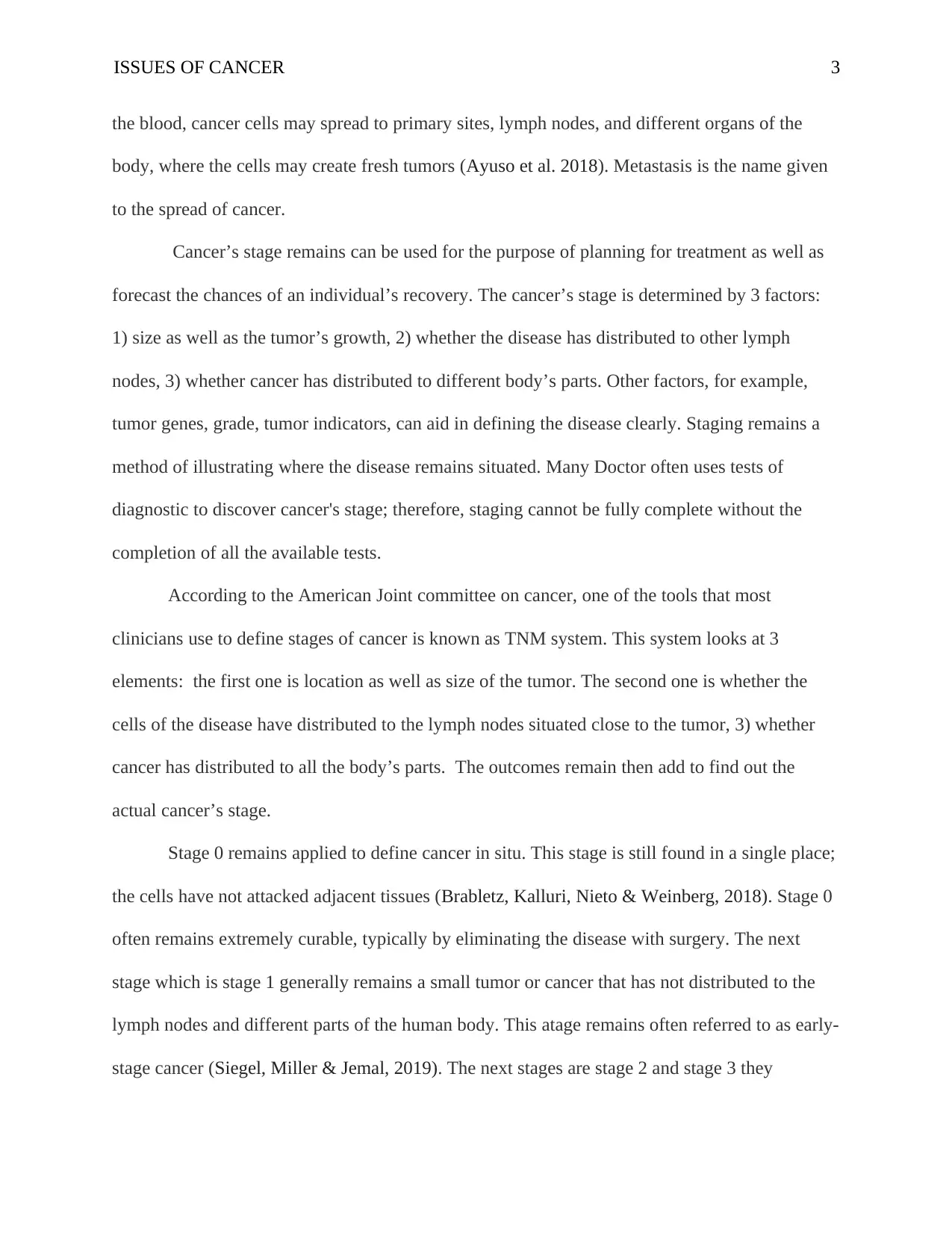
ISSUES OF CANCER 3
the blood, cancer cells may spread to primary sites, lymph nodes, and different organs of the
body, where the cells may create fresh tumors (Ayuso et al. 2018). Metastasis is the name given
to the spread of cancer.
Cancer’s stage remains can be used for the purpose of planning for treatment as well as
forecast the chances of an individual’s recovery. The cancer’s stage is determined by 3 factors:
1) size as well as the tumor’s growth, 2) whether the disease has distributed to other lymph
nodes, 3) whether cancer has distributed to different body’s parts. Other factors, for example,
tumor genes, grade, tumor indicators, can aid in defining the disease clearly. Staging remains a
method of illustrating where the disease remains situated. Many Doctor often uses tests of
diagnostic to discover cancer's stage; therefore, staging cannot be fully complete without the
completion of all the available tests.
According to the American Joint committee on cancer, one of the tools that most
clinicians use to define stages of cancer is known as TNM system. This system looks at 3
elements: the first one is location as well as size of the tumor. The second one is whether the
cells of the disease have distributed to the lymph nodes situated close to the tumor, 3) whether
cancer has distributed to all the body’s parts. The outcomes remain then add to find out the
actual cancer’s stage.
Stage 0 remains applied to define cancer in situ. This stage is still found in a single place;
the cells have not attacked adjacent tissues (Brabletz, Kalluri, Nieto & Weinberg, 2018). Stage 0
often remains extremely curable, typically by eliminating the disease with surgery. The next
stage which is stage 1 generally remains a small tumor or cancer that has not distributed to the
lymph nodes and different parts of the human body. This atage remains often referred to as early-
stage cancer (Siegel, Miller & Jemal, 2019). The next stages are stage 2 and stage 3 they
the blood, cancer cells may spread to primary sites, lymph nodes, and different organs of the
body, where the cells may create fresh tumors (Ayuso et al. 2018). Metastasis is the name given
to the spread of cancer.
Cancer’s stage remains can be used for the purpose of planning for treatment as well as
forecast the chances of an individual’s recovery. The cancer’s stage is determined by 3 factors:
1) size as well as the tumor’s growth, 2) whether the disease has distributed to other lymph
nodes, 3) whether cancer has distributed to different body’s parts. Other factors, for example,
tumor genes, grade, tumor indicators, can aid in defining the disease clearly. Staging remains a
method of illustrating where the disease remains situated. Many Doctor often uses tests of
diagnostic to discover cancer's stage; therefore, staging cannot be fully complete without the
completion of all the available tests.
According to the American Joint committee on cancer, one of the tools that most
clinicians use to define stages of cancer is known as TNM system. This system looks at 3
elements: the first one is location as well as size of the tumor. The second one is whether the
cells of the disease have distributed to the lymph nodes situated close to the tumor, 3) whether
cancer has distributed to all the body’s parts. The outcomes remain then add to find out the
actual cancer’s stage.
Stage 0 remains applied to define cancer in situ. This stage is still found in a single place;
the cells have not attacked adjacent tissues (Brabletz, Kalluri, Nieto & Weinberg, 2018). Stage 0
often remains extremely curable, typically by eliminating the disease with surgery. The next
stage which is stage 1 generally remains a small tumor or cancer that has not distributed to the
lymph nodes and different parts of the human body. This atage remains often referred to as early-
stage cancer (Siegel, Miller & Jemal, 2019). The next stages are stage 2 and stage 3 they
⊘ This is a preview!⊘
Do you want full access?
Subscribe today to unlock all pages.

Trusted by 1+ million students worldwide
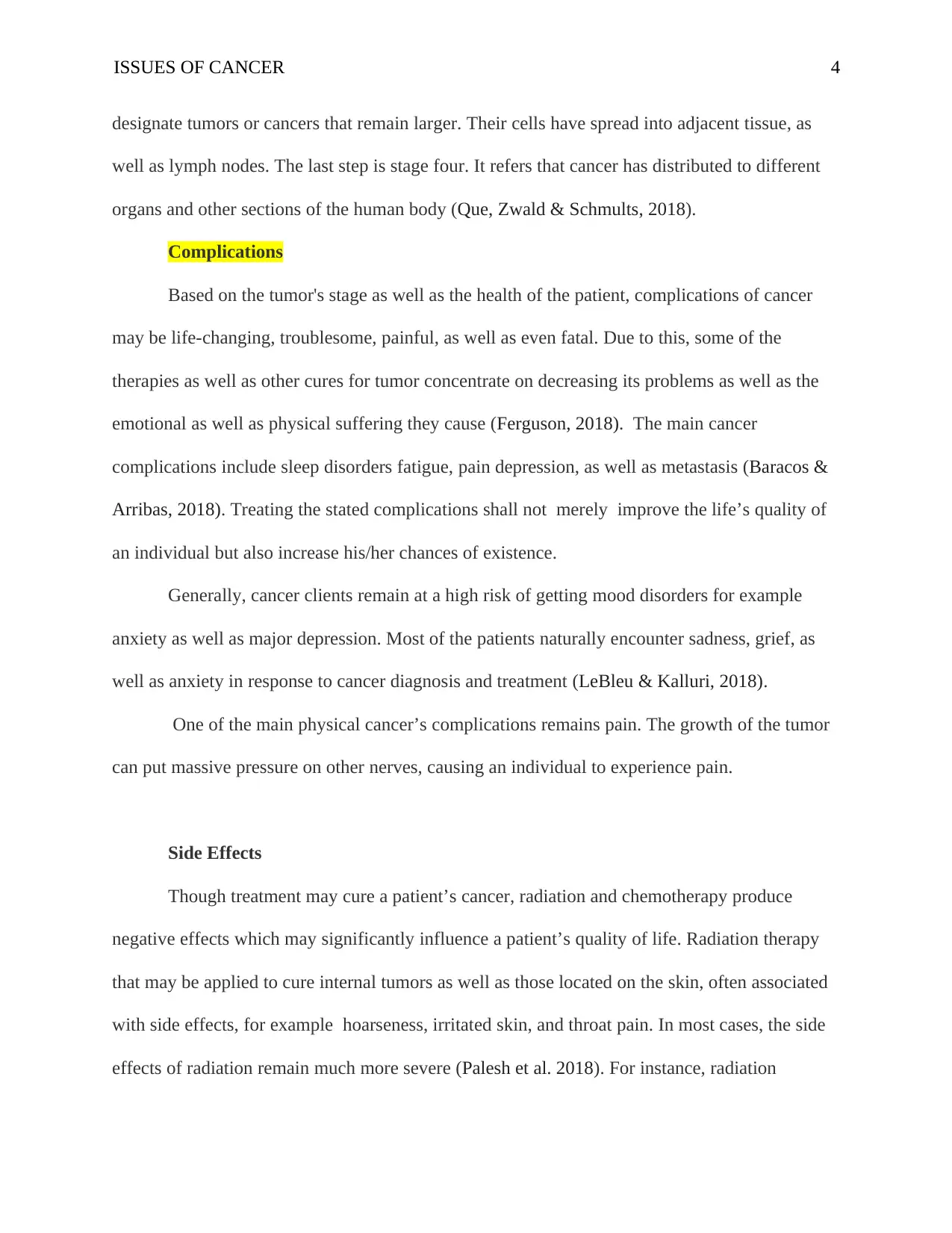
ISSUES OF CANCER 4
designate tumors or cancers that remain larger. Their cells have spread into adjacent tissue, as
well as lymph nodes. The last step is stage four. It refers that cancer has distributed to different
organs and other sections of the human body (Que, Zwald & Schmults, 2018).
Complications
Based on the tumor's stage as well as the health of the patient, complications of cancer
may be life-changing, troublesome, painful, as well as even fatal. Due to this, some of the
therapies as well as other cures for tumor concentrate on decreasing its problems as well as the
emotional as well as physical suffering they cause (Ferguson, 2018). The main cancer
complications include sleep disorders fatigue, pain depression, as well as metastasis (Baracos &
Arribas, 2018). Treating the stated complications shall not merely improve the life’s quality of
an individual but also increase his/her chances of existence.
Generally, cancer clients remain at a high risk of getting mood disorders for example
anxiety as well as major depression. Most of the patients naturally encounter sadness, grief, as
well as anxiety in response to cancer diagnosis and treatment (LeBleu & Kalluri, 2018).
One of the main physical cancer’s complications remains pain. The growth of the tumor
can put massive pressure on other nerves, causing an individual to experience pain.
Side Effects
Though treatment may cure a patient’s cancer, radiation and chemotherapy produce
negative effects which may significantly influence a patient’s quality of life. Radiation therapy
that may be applied to cure internal tumors as well as those located on the skin, often associated
with side effects, for example hoarseness, irritated skin, and throat pain. In most cases, the side
effects of radiation remain much more severe (Palesh et al. 2018). For instance, radiation
designate tumors or cancers that remain larger. Their cells have spread into adjacent tissue, as
well as lymph nodes. The last step is stage four. It refers that cancer has distributed to different
organs and other sections of the human body (Que, Zwald & Schmults, 2018).
Complications
Based on the tumor's stage as well as the health of the patient, complications of cancer
may be life-changing, troublesome, painful, as well as even fatal. Due to this, some of the
therapies as well as other cures for tumor concentrate on decreasing its problems as well as the
emotional as well as physical suffering they cause (Ferguson, 2018). The main cancer
complications include sleep disorders fatigue, pain depression, as well as metastasis (Baracos &
Arribas, 2018). Treating the stated complications shall not merely improve the life’s quality of
an individual but also increase his/her chances of existence.
Generally, cancer clients remain at a high risk of getting mood disorders for example
anxiety as well as major depression. Most of the patients naturally encounter sadness, grief, as
well as anxiety in response to cancer diagnosis and treatment (LeBleu & Kalluri, 2018).
One of the main physical cancer’s complications remains pain. The growth of the tumor
can put massive pressure on other nerves, causing an individual to experience pain.
Side Effects
Though treatment may cure a patient’s cancer, radiation and chemotherapy produce
negative effects which may significantly influence a patient’s quality of life. Radiation therapy
that may be applied to cure internal tumors as well as those located on the skin, often associated
with side effects, for example hoarseness, irritated skin, and throat pain. In most cases, the side
effects of radiation remain much more severe (Palesh et al. 2018). For instance, radiation
Paraphrase This Document
Need a fresh take? Get an instant paraphrase of this document with our AI Paraphraser
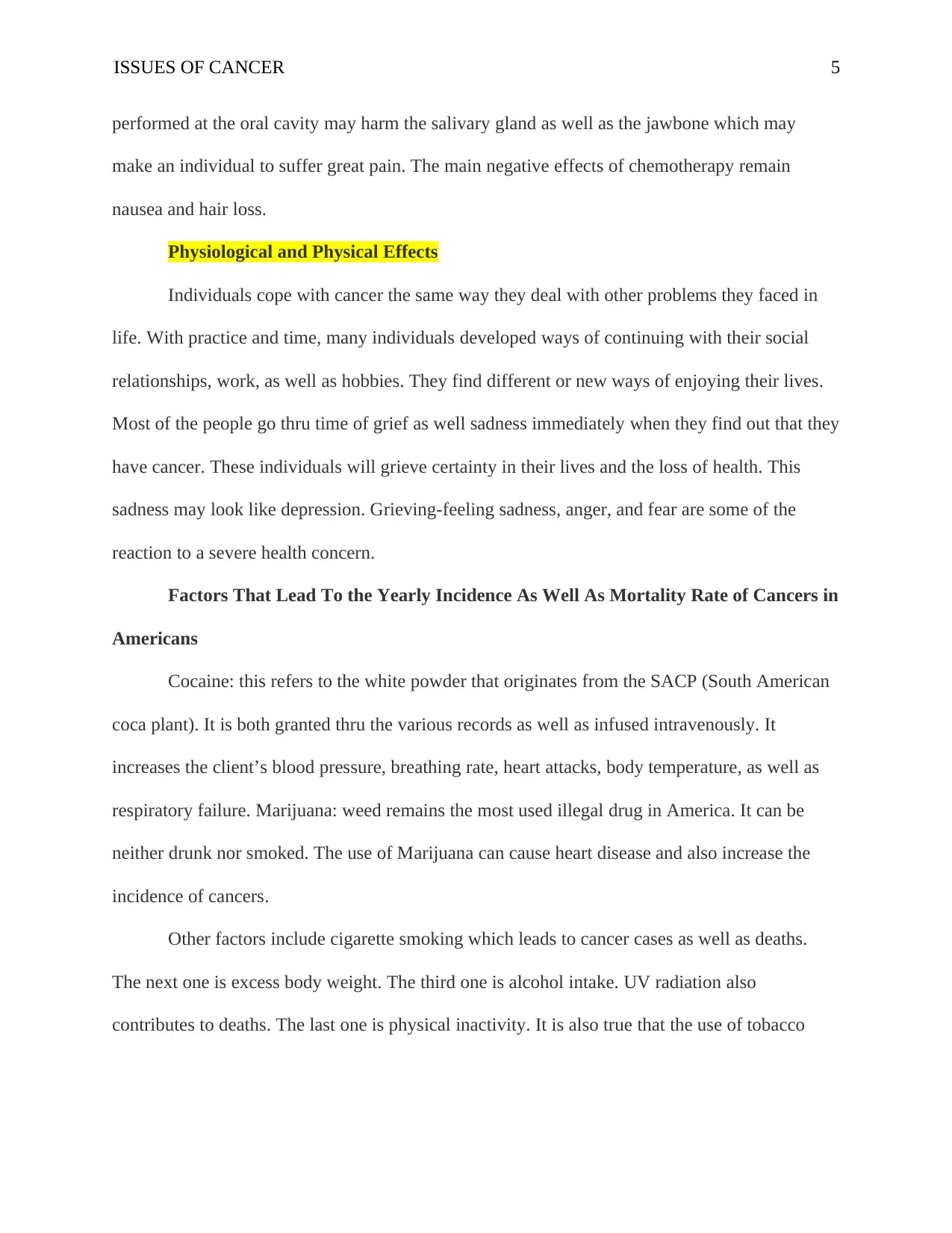
ISSUES OF CANCER 5
performed at the oral cavity may harm the salivary gland as well as the jawbone which may
make an individual to suffer great pain. The main negative effects of chemotherapy remain
nausea and hair loss.
Physiological and Physical Effects
Individuals cope with cancer the same way they deal with other problems they faced in
life. With practice and time, many individuals developed ways of continuing with their social
relationships, work, as well as hobbies. They find different or new ways of enjoying their lives.
Most of the people go thru time of grief as well sadness immediately when they find out that they
have cancer. These individuals will grieve certainty in their lives and the loss of health. This
sadness may look like depression. Grieving-feeling sadness, anger, and fear are some of the
reaction to a severe health concern.
Factors That Lead To the Yearly Incidence As Well As Mortality Rate of Cancers in
Americans
Cocaine: this refers to the white powder that originates from the SACP (South American
coca plant). It is both granted thru the various records as well as infused intravenously. It
increases the client’s blood pressure, breathing rate, heart attacks, body temperature, as well as
respiratory failure. Marijuana: weed remains the most used illegal drug in America. It can be
neither drunk nor smoked. The use of Marijuana can cause heart disease and also increase the
incidence of cancers.
Other factors include cigarette smoking which leads to cancer cases as well as deaths.
The next one is excess body weight. The third one is alcohol intake. UV radiation also
contributes to deaths. The last one is physical inactivity. It is also true that the use of tobacco
performed at the oral cavity may harm the salivary gland as well as the jawbone which may
make an individual to suffer great pain. The main negative effects of chemotherapy remain
nausea and hair loss.
Physiological and Physical Effects
Individuals cope with cancer the same way they deal with other problems they faced in
life. With practice and time, many individuals developed ways of continuing with their social
relationships, work, as well as hobbies. They find different or new ways of enjoying their lives.
Most of the people go thru time of grief as well sadness immediately when they find out that they
have cancer. These individuals will grieve certainty in their lives and the loss of health. This
sadness may look like depression. Grieving-feeling sadness, anger, and fear are some of the
reaction to a severe health concern.
Factors That Lead To the Yearly Incidence As Well As Mortality Rate of Cancers in
Americans
Cocaine: this refers to the white powder that originates from the SACP (South American
coca plant). It is both granted thru the various records as well as infused intravenously. It
increases the client’s blood pressure, breathing rate, heart attacks, body temperature, as well as
respiratory failure. Marijuana: weed remains the most used illegal drug in America. It can be
neither drunk nor smoked. The use of Marijuana can cause heart disease and also increase the
incidence of cancers.
Other factors include cigarette smoking which leads to cancer cases as well as deaths.
The next one is excess body weight. The third one is alcohol intake. UV radiation also
contributes to deaths. The last one is physical inactivity. It is also true that the use of tobacco
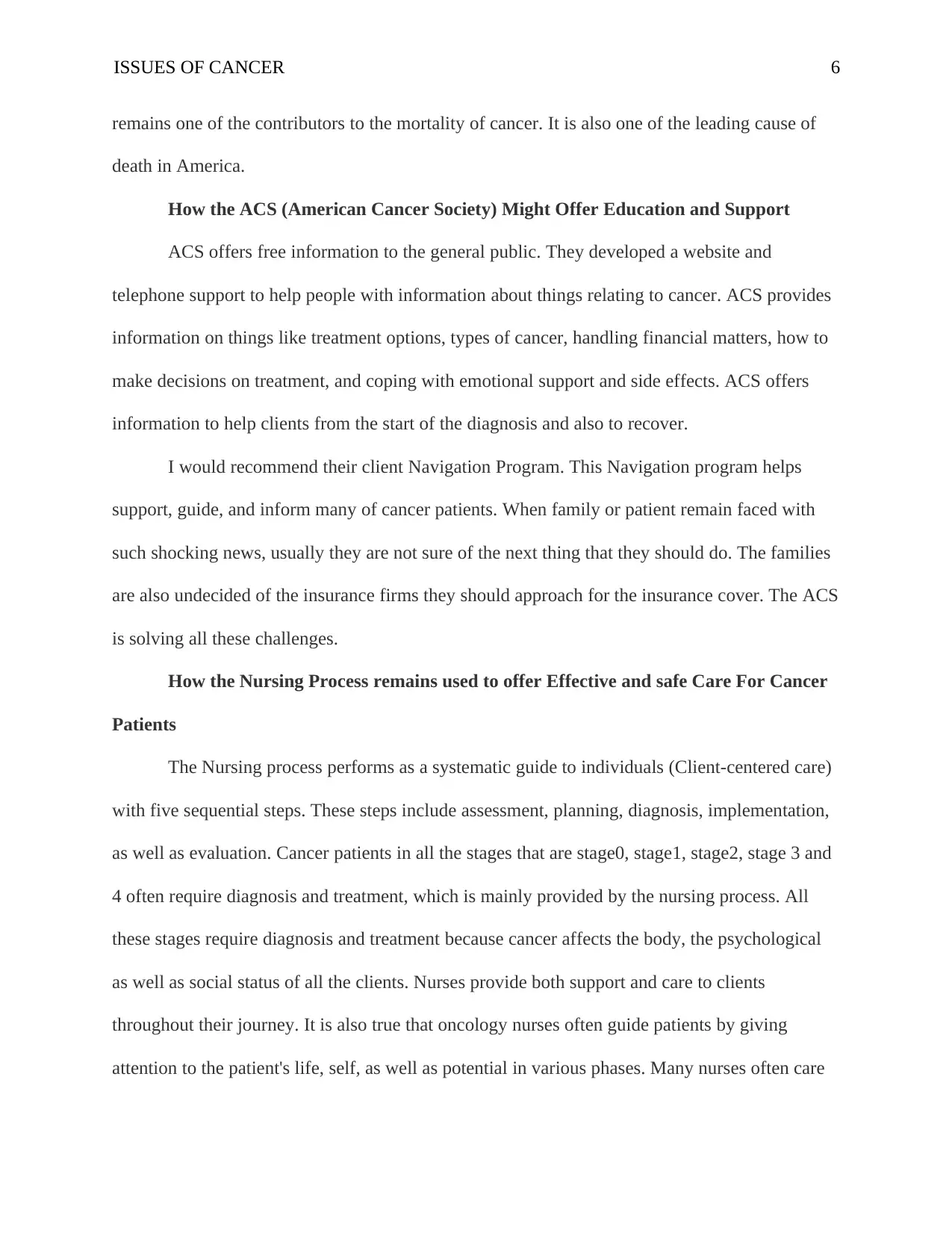
ISSUES OF CANCER 6
remains one of the contributors to the mortality of cancer. It is also one of the leading cause of
death in America.
How the ACS (American Cancer Society) Might Offer Education and Support
ACS offers free information to the general public. They developed a website and
telephone support to help people with information about things relating to cancer. ACS provides
information on things like treatment options, types of cancer, handling financial matters, how to
make decisions on treatment, and coping with emotional support and side effects. ACS offers
information to help clients from the start of the diagnosis and also to recover.
I would recommend their client Navigation Program. This Navigation program helps
support, guide, and inform many of cancer patients. When family or patient remain faced with
such shocking news, usually they are not sure of the next thing that they should do. The families
are also undecided of the insurance firms they should approach for the insurance cover. The ACS
is solving all these challenges.
How the Nursing Process remains used to offer Effective and safe Care For Cancer
Patients
The Nursing process performs as a systematic guide to individuals (Client-centered care)
with five sequential steps. These steps include assessment, planning, diagnosis, implementation,
as well as evaluation. Cancer patients in all the stages that are stage0, stage1, stage2, stage 3 and
4 often require diagnosis and treatment, which is mainly provided by the nursing process. All
these stages require diagnosis and treatment because cancer affects the body, the psychological
as well as social status of all the clients. Nurses provide both support and care to clients
throughout their journey. It is also true that oncology nurses often guide patients by giving
attention to the patient's life, self, as well as potential in various phases. Many nurses often care
remains one of the contributors to the mortality of cancer. It is also one of the leading cause of
death in America.
How the ACS (American Cancer Society) Might Offer Education and Support
ACS offers free information to the general public. They developed a website and
telephone support to help people with information about things relating to cancer. ACS provides
information on things like treatment options, types of cancer, handling financial matters, how to
make decisions on treatment, and coping with emotional support and side effects. ACS offers
information to help clients from the start of the diagnosis and also to recover.
I would recommend their client Navigation Program. This Navigation program helps
support, guide, and inform many of cancer patients. When family or patient remain faced with
such shocking news, usually they are not sure of the next thing that they should do. The families
are also undecided of the insurance firms they should approach for the insurance cover. The ACS
is solving all these challenges.
How the Nursing Process remains used to offer Effective and safe Care For Cancer
Patients
The Nursing process performs as a systematic guide to individuals (Client-centered care)
with five sequential steps. These steps include assessment, planning, diagnosis, implementation,
as well as evaluation. Cancer patients in all the stages that are stage0, stage1, stage2, stage 3 and
4 often require diagnosis and treatment, which is mainly provided by the nursing process. All
these stages require diagnosis and treatment because cancer affects the body, the psychological
as well as social status of all the clients. Nurses provide both support and care to clients
throughout their journey. It is also true that oncology nurses often guide patients by giving
attention to the patient's life, self, as well as potential in various phases. Many nurses often care
⊘ This is a preview!⊘
Do you want full access?
Subscribe today to unlock all pages.

Trusted by 1+ million students worldwide

ISSUES OF CANCER 7
about what is essential to the patient. The five crucial steps in the nursing process are always
being used to provide useful and safe care for cancer clients.
Undergraduate Education
Undergraduate education may assist in many ways, although it remains not evident at
first. When nurses joined the undergraduate program, they take different courses, for example,
math, Spanish, and English. All these courses are relevant to the education of nurses in STEM.
All these act as a foundation. Nurses are educated on how to write different papers more so in
English. This will prepare nurses on how to write lab reports and research papers. Nurses may
also improve their communication method in the workplace. These courses teach nurses to solve
problems and critically think. Math also helps in medicine because it allows nurses to give
dosage and conversion. Therefore, these courses are essential because they act as a foundation
for the career of nursing.
In conclusion, this paper mainly discussed issues that relate to cancer. Some of the issues
discussed include the risk factors of cancers, such as alcohol abuse and cigarette smoking. This
paper also discussed some of the stages of the disease. The stages discussed include stage0,
stage2, stage 3, and 4. This paper also indicated how the American Cancer Society might offer
support and education to the people.
about what is essential to the patient. The five crucial steps in the nursing process are always
being used to provide useful and safe care for cancer clients.
Undergraduate Education
Undergraduate education may assist in many ways, although it remains not evident at
first. When nurses joined the undergraduate program, they take different courses, for example,
math, Spanish, and English. All these courses are relevant to the education of nurses in STEM.
All these act as a foundation. Nurses are educated on how to write different papers more so in
English. This will prepare nurses on how to write lab reports and research papers. Nurses may
also improve their communication method in the workplace. These courses teach nurses to solve
problems and critically think. Math also helps in medicine because it allows nurses to give
dosage and conversion. Therefore, these courses are essential because they act as a foundation
for the career of nursing.
In conclusion, this paper mainly discussed issues that relate to cancer. Some of the issues
discussed include the risk factors of cancers, such as alcohol abuse and cigarette smoking. This
paper also discussed some of the stages of the disease. The stages discussed include stage0,
stage2, stage 3, and 4. This paper also indicated how the American Cancer Society might offer
support and education to the people.
Paraphrase This Document
Need a fresh take? Get an instant paraphrase of this document with our AI Paraphraser
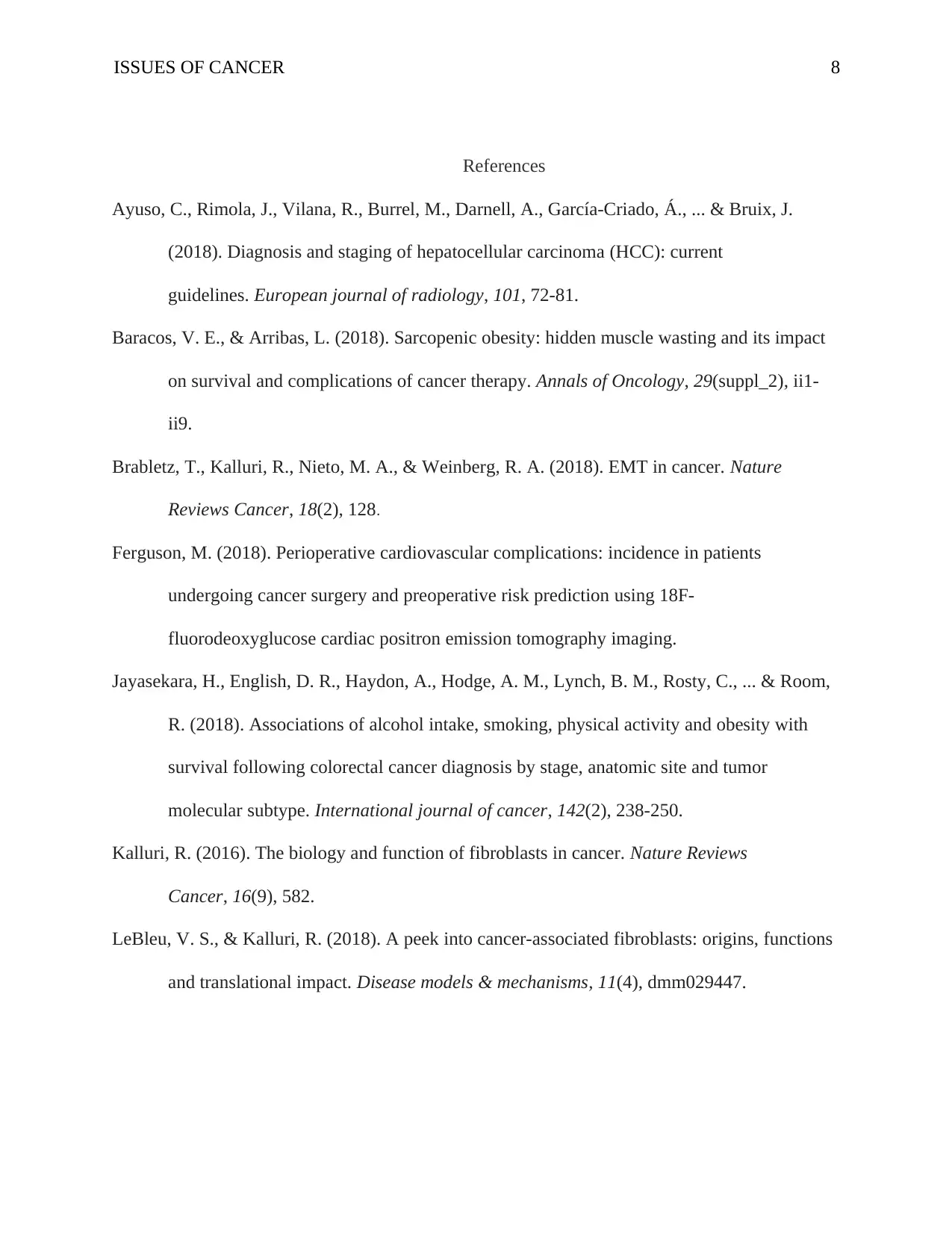
ISSUES OF CANCER 8
References
Ayuso, C., Rimola, J., Vilana, R., Burrel, M., Darnell, A., García-Criado, Á., ... & Bruix, J.
(2018). Diagnosis and staging of hepatocellular carcinoma (HCC): current
guidelines. European journal of radiology, 101, 72-81.
Baracos, V. E., & Arribas, L. (2018). Sarcopenic obesity: hidden muscle wasting and its impact
on survival and complications of cancer therapy. Annals of Oncology, 29(suppl_2), ii1-
ii9.
Brabletz, T., Kalluri, R., Nieto, M. A., & Weinberg, R. A. (2018). EMT in cancer. Nature
Reviews Cancer, 18(2), 128.
Ferguson, M. (2018). Perioperative cardiovascular complications: incidence in patients
undergoing cancer surgery and preoperative risk prediction using 18F-
fluorodeoxyglucose cardiac positron emission tomography imaging.
Jayasekara, H., English, D. R., Haydon, A., Hodge, A. M., Lynch, B. M., Rosty, C., ... & Room,
R. (2018). Associations of alcohol intake, smoking, physical activity and obesity with
survival following colorectal cancer diagnosis by stage, anatomic site and tumor
molecular subtype. International journal of cancer, 142(2), 238-250.
Kalluri, R. (2016). The biology and function of fibroblasts in cancer. Nature Reviews
Cancer, 16(9), 582.
LeBleu, V. S., & Kalluri, R. (2018). A peek into cancer-associated fibroblasts: origins, functions
and translational impact. Disease models & mechanisms, 11(4), dmm029447.
References
Ayuso, C., Rimola, J., Vilana, R., Burrel, M., Darnell, A., García-Criado, Á., ... & Bruix, J.
(2018). Diagnosis and staging of hepatocellular carcinoma (HCC): current
guidelines. European journal of radiology, 101, 72-81.
Baracos, V. E., & Arribas, L. (2018). Sarcopenic obesity: hidden muscle wasting and its impact
on survival and complications of cancer therapy. Annals of Oncology, 29(suppl_2), ii1-
ii9.
Brabletz, T., Kalluri, R., Nieto, M. A., & Weinberg, R. A. (2018). EMT in cancer. Nature
Reviews Cancer, 18(2), 128.
Ferguson, M. (2018). Perioperative cardiovascular complications: incidence in patients
undergoing cancer surgery and preoperative risk prediction using 18F-
fluorodeoxyglucose cardiac positron emission tomography imaging.
Jayasekara, H., English, D. R., Haydon, A., Hodge, A. M., Lynch, B. M., Rosty, C., ... & Room,
R. (2018). Associations of alcohol intake, smoking, physical activity and obesity with
survival following colorectal cancer diagnosis by stage, anatomic site and tumor
molecular subtype. International journal of cancer, 142(2), 238-250.
Kalluri, R. (2016). The biology and function of fibroblasts in cancer. Nature Reviews
Cancer, 16(9), 582.
LeBleu, V. S., & Kalluri, R. (2018). A peek into cancer-associated fibroblasts: origins, functions
and translational impact. Disease models & mechanisms, 11(4), dmm029447.
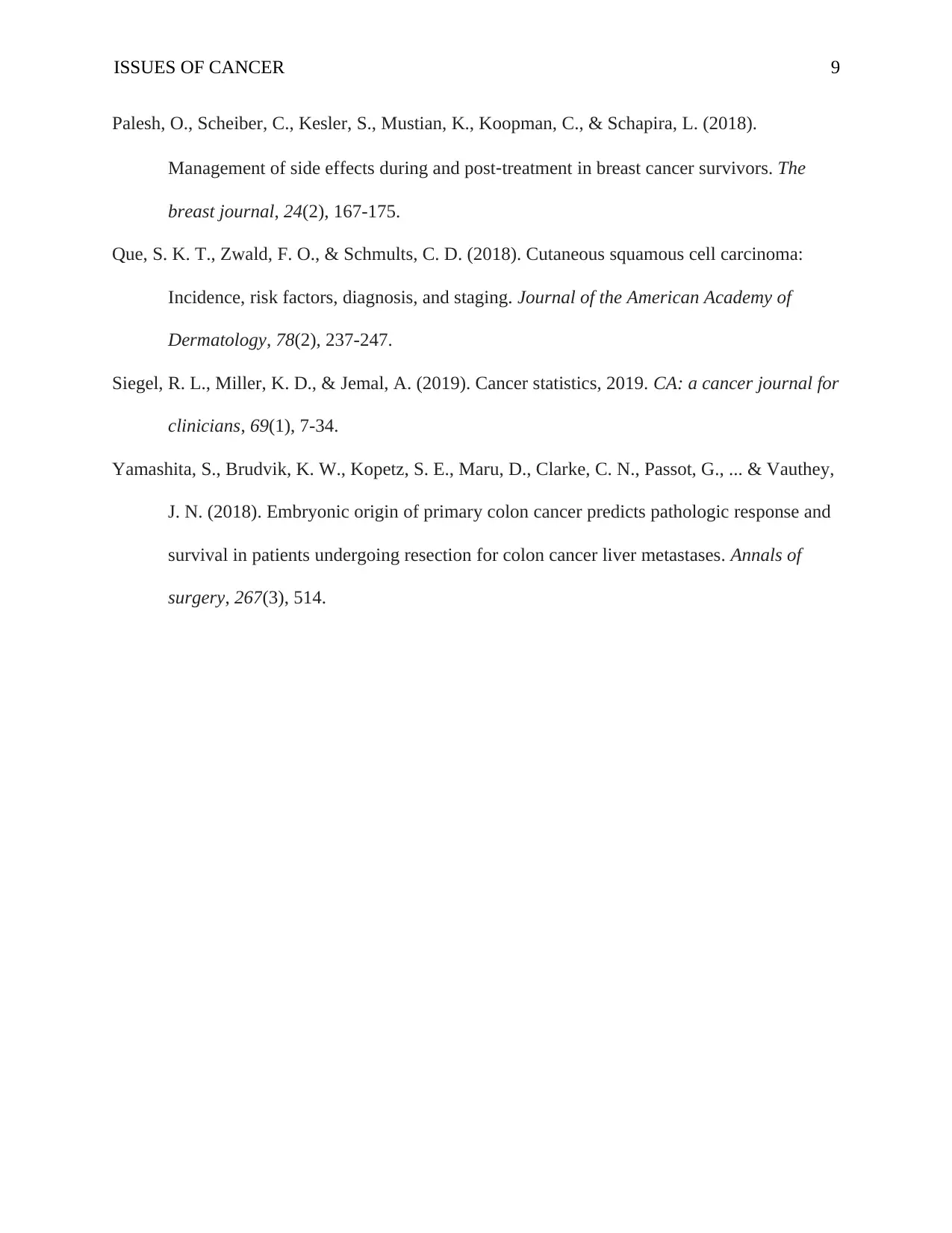
ISSUES OF CANCER 9
Palesh, O., Scheiber, C., Kesler, S., Mustian, K., Koopman, C., & Schapira, L. (2018).
Management of side effects during and post‐treatment in breast cancer survivors. The
breast journal, 24(2), 167-175.
Que, S. K. T., Zwald, F. O., & Schmults, C. D. (2018). Cutaneous squamous cell carcinoma:
Incidence, risk factors, diagnosis, and staging. Journal of the American Academy of
Dermatology, 78(2), 237-247.
Siegel, R. L., Miller, K. D., & Jemal, A. (2019). Cancer statistics, 2019. CA: a cancer journal for
clinicians, 69(1), 7-34.
Yamashita, S., Brudvik, K. W., Kopetz, S. E., Maru, D., Clarke, C. N., Passot, G., ... & Vauthey,
J. N. (2018). Embryonic origin of primary colon cancer predicts pathologic response and
survival in patients undergoing resection for colon cancer liver metastases. Annals of
surgery, 267(3), 514.
Palesh, O., Scheiber, C., Kesler, S., Mustian, K., Koopman, C., & Schapira, L. (2018).
Management of side effects during and post‐treatment in breast cancer survivors. The
breast journal, 24(2), 167-175.
Que, S. K. T., Zwald, F. O., & Schmults, C. D. (2018). Cutaneous squamous cell carcinoma:
Incidence, risk factors, diagnosis, and staging. Journal of the American Academy of
Dermatology, 78(2), 237-247.
Siegel, R. L., Miller, K. D., & Jemal, A. (2019). Cancer statistics, 2019. CA: a cancer journal for
clinicians, 69(1), 7-34.
Yamashita, S., Brudvik, K. W., Kopetz, S. E., Maru, D., Clarke, C. N., Passot, G., ... & Vauthey,
J. N. (2018). Embryonic origin of primary colon cancer predicts pathologic response and
survival in patients undergoing resection for colon cancer liver metastases. Annals of
surgery, 267(3), 514.
⊘ This is a preview!⊘
Do you want full access?
Subscribe today to unlock all pages.

Trusted by 1+ million students worldwide
1 out of 9
Related Documents
Your All-in-One AI-Powered Toolkit for Academic Success.
+13062052269
info@desklib.com
Available 24*7 on WhatsApp / Email
![[object Object]](/_next/static/media/star-bottom.7253800d.svg)
Unlock your academic potential
Copyright © 2020–2025 A2Z Services. All Rights Reserved. Developed and managed by ZUCOL.





